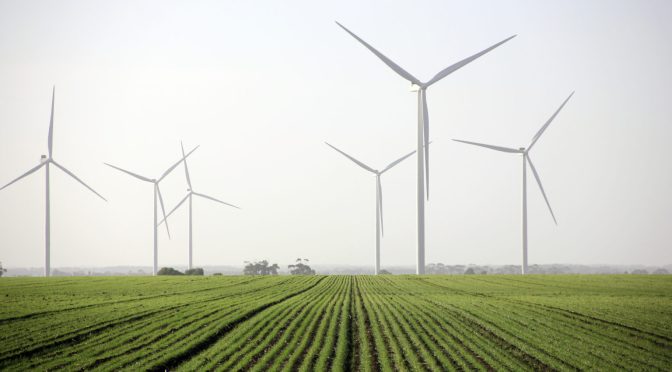Like many things, solving the climate crisis is all about science and maths.
According to Energy Minister Chris Bowen, Australia needs to be building 40 wind turbines every month until 2030 (plus a whole lot of solar panels and transmission lines) to meet his government’s ambitious renewable energy target.
Given he said this towards the end of 2022, that’s approximately 3840 turbines in eight years.
Putting aside the fact that this will require vast amounts of steel, concrete – and workers – it’s also about where these turbines will be built.
And here’s where the maths of the climate challenge is defied by politics.
It’s not easy to find precise data on the number of turbines under construction. But according to the Clean Energy Council, only three wind farms with a total of 115 turbines were commissioned and connected to grid across Australia last year.
There are a range of reasons for the sluggish pace of development from chaotic energy policies to a congested transmission network and community pushback to both renewable and transmission projects.
But according to industry insiders, the time it’s taking to get approval for large-scale wind and solar projects is the biggest bottleneck in this once-in-a-century transition — especially in New South Wales.
Analysis by law-firm Herbert Smith Freehills and the Clean Energy Investor Group (CEIG) found that for the last five years, the average approval time frame for large-scale renewable energy projects in NSW was 746 days.
Approval time frames:
- 3488 days for wind projects (9.5 years)
- 705 days for solar projects (2.5 years)
- 530 days for battery projects (1.5 years)
The report also points the finger at the Commonwealth where bureaucrats are generally taking up to three years to assess a project under federal environmental laws, “causing significant delays”.
Put simply, these delays are “slowing the pace of the energy transition” according to CEIG Chief Executive Simon Corbell, who said it should be taking no more than 18 months for a project to be ticked off by both state and federal authorities.
“New South Wales is … unfortunately regarded as one of the most difficult states when it comes to the approval and assessment of clean energy projects” said Mr Corbell, who noted some companies were instead choosing to develop projects in Queensland, which has a state-owned electricity network and much clearer planning rules.
On any given day, roughly 60 per cent of Australia’s power comes from black and brown coal and about 32 per cent from wind, solar and hydro. Within six years, the government wants to dramatically increase the share of renewables to 82 per cent, more than doubling the current clean generation capacity.
The political stakes are high for a government that needs to keep the lights on, and power prices down, as the nation’s aging fleet of coal-fired power stations retires.
But in the past 2.5 years, only two large-scale wind farms have been approved in NSW and some developers are being forced to scale back projects because of what they say are the state’s cumbersome planning rules.
Acciona’s Orana wind farm near Dunedoo, in western NSW, had promised to produce 600 megawatts of power but late last year, the energy giant quietly slashed the project’s capacity by two-thirds to 250 megawatts.
That project is in the heart of the Central West Orana Renewable Energy Zone (REZ) which the NSW government has slated to produce six gigawatts of clean energy to help power the nation as coal-fired power stations close.
In a statement, the NSW Planning Department said it had reduced assessment times for new projects by 60 per cent since 2016 but it added industry had a key role to play: of the 93 large-scale wind and solar farms it had approved, 55 were still not operating.
One of them is the Liverpool Range Wind Farm, also in the Central West REZ, which was given state and federal government approval in 2018 and a year later, sold to another developer, Tilt Renewables.
Tilt then applied to modify the project, reducing the number of turbines to 185 but increasing their height from 165 metres to 215 metres, which the Warrumbungle Shire Council objected to.
But if Australia is to have an “orderly” exit from coal, Mr Corbell said all governments “need to lift their game” and reckons the solution lies in a simple ‘critical infrastructure’ declaration.
“We have laws that give timely assessment for that infrastructure, laws that allow roads to be built, laws that allow ports to be built, and even laws that allow our mines to be built,” he said.
With limited accommodation in the region, Tilt made another application last year to build a temporary workers’ camp, as well as a quarry for the cement the project would require. Both are still being assessed.
Warrumbungle Mayor Ambrose Doolan — whose shire has 11 renewable projects in the pipeline — said the peace meal approach to development applications was frustrating.
“A lot of that trouble is self-inflicted I believe, in that they only come with half the facts,” Cr Doolan said.
“That should’ve been presented to the Department of Planning as a complete package at the start and that’s where the hold-up lies in my view.”
Tilt Renewables is aiming to begin construction on the wind farm in 2025 (although that timing is also dependent on the construction of a new, high-voltage transmission line) and once complete, will supply enough power to 570,000 homes.
NSW has drafted new guidelines for renewable energy development, it hopes, will smooth the transition in that state from here.


